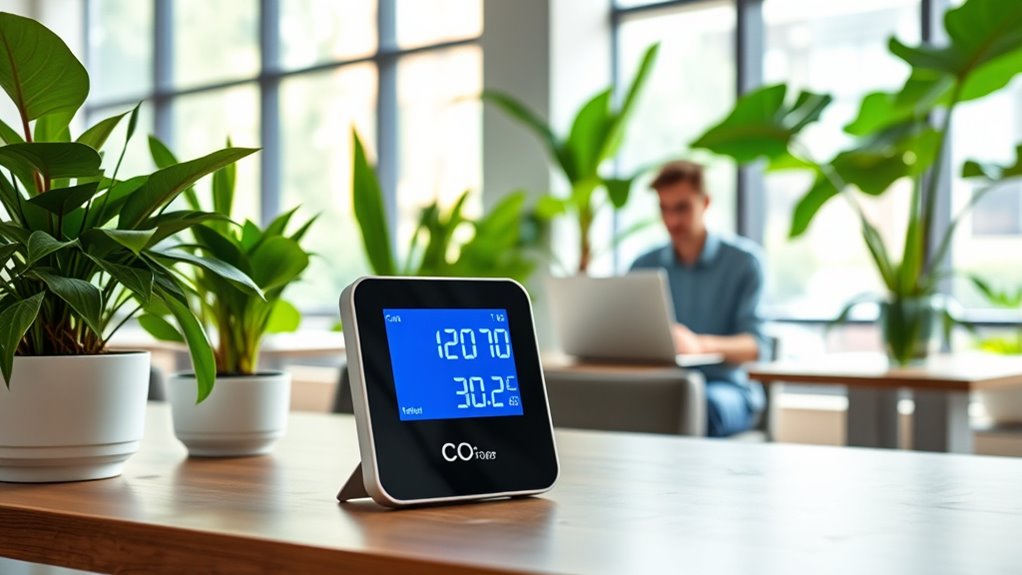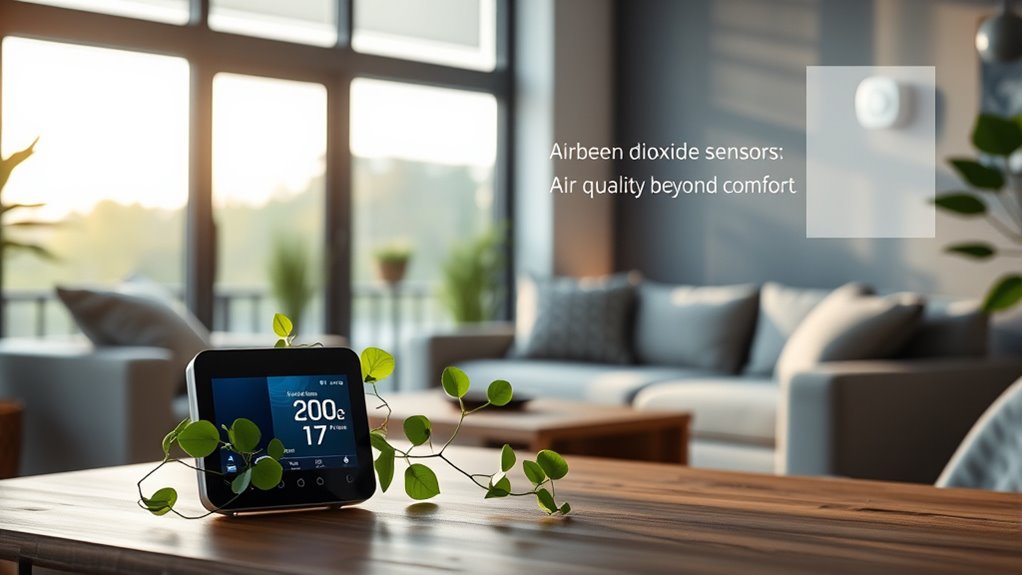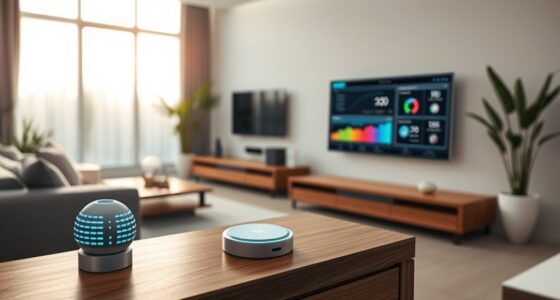Monitoring indoor CO₂ levels matters beyond comfort because it directly impacts your health, productivity, and safety. Elevated CO₂ indicates poor ventilation, which can lead to headaches, fatigue, and long-term respiratory issues. By using sensors, you can guarantee good air quality, improve focus, and lower risks of indoor pollutants. Keeping an eye on CO₂ levels helps you take targeted action, making your space healthier and safer—there’s more to discover if you stay tuned.
Key Takeaways
- Elevated CO₂ levels can indicate poor ventilation, leading to health issues and reduced cognitive performance.
- Continuous CO₂ monitoring helps identify when indoor air quality dips below safe standards, enabling timely action.
- Data-driven ventilation management reduces indoor pollutants, improving overall health and safety for occupants.
- Monitoring supports proactive maintenance and upgrades of HVAC systems, ensuring long-term indoor air quality.
- Beyond comfort, maintaining optimal CO₂ levels safeguards health, enhances productivity, and promotes well-being.

Have you ever wondered how safe the air inside your home or office really is? It’s easy to overlook, but the quality of the air you breathe directly impacts your health, productivity, and overall well-being. One critical aspect of indoor air quality is monitoring CO₂ levels. Elevated carbon dioxide isn’t just a discomfort; it can cause drowsiness, reduced concentration, and even health problems over time. That’s why investing in air quality sensors is essential—they act as your early warning system, providing real-time data on CO₂ concentrations. These sensors are compact, easy to install, and offer continuous monitoring, so you always know when the air quality dips below healthy standards.
Once you have a clear picture of your indoor CO₂ levels, you can implement effective ventilation strategies. Proper ventilation isn’t just about opening windows; it involves a thoughtful approach that balances fresh air intake with energy efficiency. Mechanical ventilation systems, such as HVAC upgrades equipped with sensors, can automatically adjust airflow based on real-time data, ensuring your space remains healthy without wasting energy. Natural ventilation, like opening windows during peak fresh air times, also plays an essential role, especially if your space allows for cross-ventilation. The key is to use the data from air quality sensors to optimize these strategies, ensuring you’re not just guessing but making informed decisions.
Monitoring CO₂ levels isn’t only about comfort—it’s a proactive way to safeguard health. High indoor CO₂ can be a sign of poor ventilation and increased indoor pollutants, including allergens and volatile organic compounds. When you know the air quality, you can take targeted actions, such as increasing ventilation during peak occupancy or upgrading your HVAC system. Additionally, advances in robotics integration are making it easier to automate ventilation controls and maintain optimal indoor air quality efficiently. This approach reduces the risk of respiratory issues, allergies, and other health concerns linked to indoor air pollution. Furthermore, maintaining good air quality enhances cognitive function, making it easier to focus and perform tasks efficiently. It’s an investment that benefits both your physical health and mental clarity.
In essence, understanding and controlling indoor CO₂ levels is a smart move for anyone looking to create healthier living and working environments. Air quality sensors are your best allies—they provide the critical data needed to implement effective ventilation strategies. By staying vigilant and responsive to these readings, you can ensure the air you breathe indoors remains clean, fresh, and safe. It’s a simple yet powerful step toward a healthier lifestyle, proving that monitoring indoor air quality is about more than comfort—it’s about protecting your health every day.
Frequently Asked Questions
How Does Indoor Co₂ Affect Students’ Concentration and Learning?
Indoor CO₂ levels directly impact students’ concentration and learning by affecting air quality and cognitive performance. When CO₂ builds up, it can cause drowsiness, reduce alertness, and impair decision-making skills. You might notice students struggling to focus or retain information. Improving ventilation and monitoring CO₂ helps guarantee ideal air quality, so students stay alert, engaged, and perform at their best academically.
Can High Co₂ Levels Cause Long-Term Health Issues?
High CO₂ levels can indeed cause long-term health issues. You might experience long-term respiratory problems, especially if exposure continues over years. Elevated CO₂ can also contribute to cognitive decline, affecting your ability to think clearly and make decisions. Regularly monitoring indoor CO₂ helps you maintain healthy levels, reducing the risk of these serious health issues. Staying proactive guarantees your indoor environment supports both your immediate comfort and long-term well-being.
What Are the Best Devices for Real-Time Co₂ Monitoring?
Imagine dodging invisible toxins every day—that’s what real-time CO₂ monitoring can prevent. You need reliable air quality sensors or portable monitors that give instant readings, so you can act fast. Look for devices with accurate sensors, easy-to-read displays, and Bluetooth connectivity, like the Aranet4 or Airthings Wave Plus. These tools help you breathe easier, ensuring your indoor air stays safe and healthy all day long.
How Often Should Indoor Co₂ Levels Be Checked?
You should check indoor CO₂ levels regularly, ideally every few hours, especially in occupied spaces. Consistently monitoring air quality helps you identify when ventilation strategies need adjustment to maintain healthy air. If levels rise above 800 ppm, increase ventilation to improve air quality and reduce potential health risks. Regular checks guarantee your indoor environment stays fresh, safe, and comfortable for everyone.
Are There Specific Indoor Environments More Prone to Co₂ Buildup?
Imagine a sealed treasure chest, trapping valuable air inside. Some indoor environments, like confined spaces or poorly ventilated rooms, are more prone to CO₂ buildup due to ventilation challenges. These spaces restrict airflow, making it harder to replace stale air. You should pay special attention to these areas, ensuring proper ventilation, so that CO₂ levels stay safe and comfortable, protecting both health and well-being.
Conclusion
By monitoring indoor CO₂ levels, you’re not just ensuring comfort—you’re defending your very life! Ignoring these invisible dangers could turn your home into a toxic trap, slowly suffocating you and your loved ones without a single warning. Don’t let complacency be your downfall. Take action now, detect the danger early, and breathe easy knowing you’re safeguarding your health from an unseen enemy that could strike at any moment. Your life depends on it!









